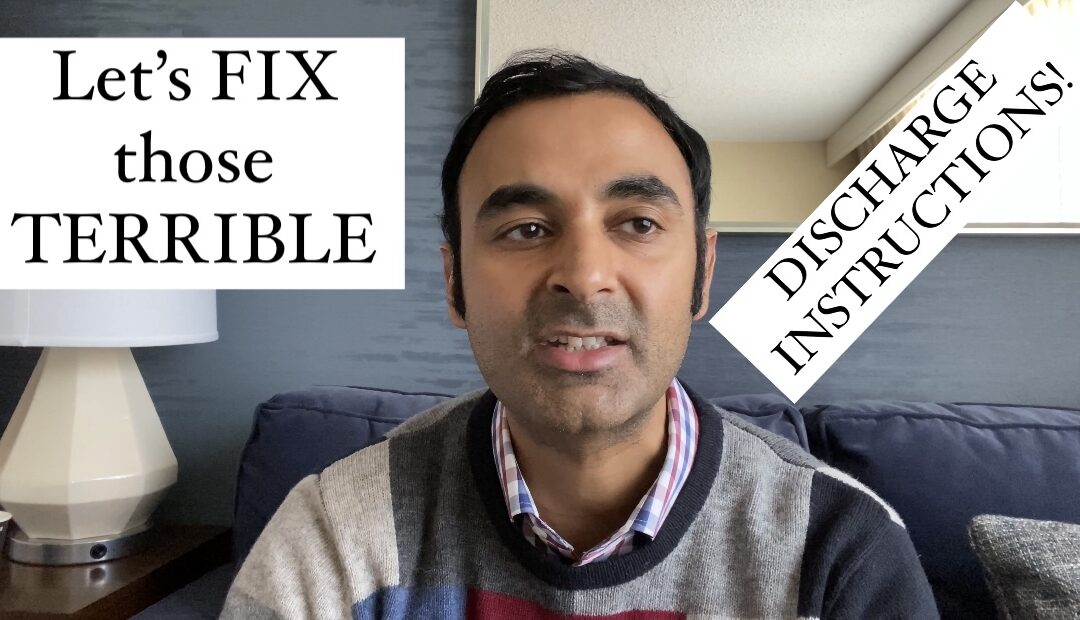The follow-up advice we give our patients when they leave our care in the hospital, is one of the most under-talked about areas where we are currently falling down in healthcare. I’m not going to mince words here. I believe the discharge instructions paperwork that thousands of patients are getting all across the country every day, are absolutely atrocious! Let me back up here and explain what I’m talking about and why this is a serious issue.
Years ago, before the widespread adoption of electronic medical records (EMRs), we used to give patients a handwritten list of instructions telling them what to do after they leave the hospital. This was less than ideal—doctors’ handwriting is not exactly known for being perfect and legible. Fast forward to what’s happened over the last several years, as EMRs have been rolled out and everything is now computerized. I speak as someone who has worked in dozens of hospitals in different states, with almost every electronic medical record out there. The print-out that is generated to give our medical patients upon discharge is universally terrible! Typically, it’s a garbled mish-mash of information, several pages long, that you can’t make head or tail of. The writing is tiny—and the whole thing is basically incomprehensible. How on earth are elderly patients supposed to understand this? Literally no thought or common sense has gone into it.
This is a problem for multiple reasons, but not least the fact that discharging any patient from the hospital is actually quite a dangerous moment when you think about it. Patients are still very fragile—especially the elderly and medically complex. They frequently end up leaving in a rushed and confused process, as hospitals—which face enormous pressure—are in a hurry to free up the bed. Questions are left unanswered and patients and their families, often realize afterwards that they have additional concerns. I actually have a term for this: The Discharge Haze.
I’ve actually gotten so frustrated with electronic medical records, that I have figured a way around this for my patients when it comes to their discharge paperwork. As I explain in the above video, I simply copy and paste the information that I have entered into the computer, onto a Word document. Larger writing and spaced out bullet points explaining what to do next. The basic template looks like this:
——————————————————————————————-
Discharge Instructions for: Mr Joe Bloggs
Diagnosis: Chest pain, dizziness, slow heart rate
Instructions:
1.Follow-up with your primary care physician in 1 week and cardiologist in 2 weeks
2.Repeat your BMP blood test in 1 week to monitor your kidney function and electrolytes
3.Your metoprolol dose has been reduced to 25 mg daily. Please discuss this at your next clinic visit
4.Go over your CT scan report with your primary care physician (you have been given a copy of the report, and may need a follow-up after 3 months)
5.Please seek urgent medical attention if you have any chest pain, shortness of breath, palpitations or dizziness
*Additional info like dressing changes, dietary restrictions etc, can also be added above
——————————————————————————————-
I receive excellent feedback from my patients about this simple sheet of paper I give to them. It literally takes 30 seconds to do, and far eclipses the rubbish that is computer-generated.
My advice to any physician or other healthcare professional taking care of patients, who sees this same issue I do with electronic medical records, is consider doing the same thing with your discharge instructions. I hope that one day, our computer systems will fix this, but I’m not too optimistic. This is a classic example of how we fall over with the simple little things in healthcare. And too often these issues hinge around our lack of good communication. I repeat: no patient should ever leave hospital without being crystal clear on what comes next.
 Suneel Dhand is a physician, writer, and YouTuber. He is Founder at MedStoic Lifestyle Medicine and DocsDox . Follow him on YouTube and Instagram
Suneel Dhand is a physician, writer, and YouTuber. He is Founder at MedStoic Lifestyle Medicine and DocsDox . Follow him on YouTube and Instagram


Dang! I lost the whole message so here is a repeat! And it raised red flags for me! As long as the insurance paper work is filled out and boxes checked, it doesn’t make a difference whether the patient understands the orders. There is no one there to explain it to them.
In the old days, a care plan, done by nurses was laid out including discharge planning as soon as the patient was admitted and they followed through so that patient and family understood what they had to do. I can remember teaching patient and family how to give insulin by injection or care of an ostomy bag.
It wasn’t the advent of EMR’s that changed the scene, it was that hospitals let nurses go because they didn’t want to pay the salaries they were asking. Sad to say. that has lead to greater morbidity and mortality.
Hospital care today is atrocious! Instead of a bed bath and back rub, patients now get a hand-wipe to cleanse themselves. Get
’em in and get ’em out as soon as possible whether they know how to take care of themselves or not. A bed is needed, out you go whether you have a ride home or a family member to take care of you. Social workers? Where are they in this process?
I feel so sorry for those without any medical assistance backup when they get home. I very frequently am asked what to do because the discharge patients didn’t know and I graduated 60 years ago!. That is not my job! It is the hospital and the medical personnel to see that their discharging patients have a way to deal with what is next for them.
Amen
Hi Sue, I am 110% sure in the older days you refer to, patients had much clearer discharge instructions! We have lost so much in 2021… Best, Suneel
Excellent points Suneel!!!
Beyond the problems with the EMR, the hospital legal team probably has also played a role in the complexity of the discharge paperwork. What you are doing for clarity is excellent, (but please be careful as the hospital might not like you superseding their discharge forms).
As a house call physician, I am on the receiving end of discharge paperwork, and for sure patients do not understand what their diagnosis was, what tests were run, nor any treatment plan.
When I read the paperwork, it is gobbledygook and even nonsense.
Continuity in care is important, but a patient and family members should understand what happened during the hospitalization. Going back to the hospital legal team, they want patients shrouded in complexity.
Very sad how we have to now practice medicine. Thank you for bringing forward this important issue.
Gene Dorio, M.D.
Santa Clarita, CA
Thanks Gene, glad you see the problem too. The info I copy and paste over, is exactly the same as is on the DC instructions– simply more eye-catching and readable (esp for our elderly patients)! Regards, Suneel Dhand